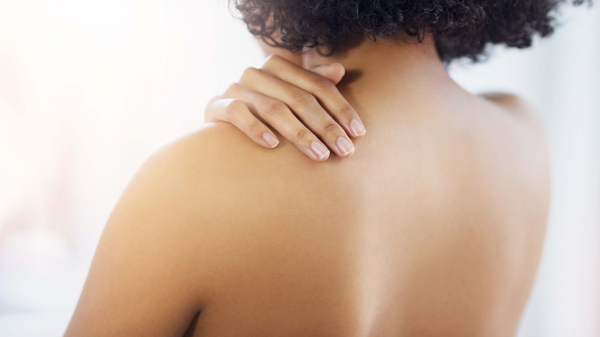 Getty Images/LaylaBird
Getty Images/LaylaBird
As a pre-teen athlete, body acne and I had our fair share of confrontations. Rushing between my school’s varsity volleyball practice — sliding on the floor as the team’s libero — followed by a 15-minute car ride to club soccer practice, my skin was on overload between sweaty, tight jerseys and, of course, puberty. On those days when my shoulder blades were flush with whiteheads and my chest with tiny red bumps, I contemplated quitting my passion for sports, all in the name of feeling “pretty” in a tank top or bikini. For years, body acne became a giant insecurity I let take control of me — instead of me working to control it. That was all until I made a dermatologist appointment where I finally saw hope and light at the end of the tunnel. Thanks to my newfound knowledge of topical retinoids, I’m now able to continue pursuing the active lifestyle I’ve always loved dearly.
What Is Body Acne, Exactly?
Before jumping into the benefits of topical ointments, like retinoids, Rhode Island-based board-certified dermatologist Tiffany Jow Libby breaks down what causes body acne in the first place. “Acne, regardless of whether on the face or body, occurs due to several factors: clogged pores, excess oil production, and inflammation,” she says. Although blackheads are still common and can occur on the body, Libby’s practice tends to see “more whiteheads, inflammatory acne, and cysts on the body, which are prone to more oil production — along the back and chest.”
Claire Chang, a board-certified dermatologist in New York City, also calls out “hormonal fluctuations, stress, and certain foods (including dairy and high glycemic diets) as acne triggers,'' too. While whiteheads are commonly seen on many of her patients' bodies, she says, blemishes like papules, pustules, cysts, and nodules all can show up on the skin barrier.
While body acne can affect people of all ages, both Libby and Chang name puberty as the starting point for many cases. “Hormones called androgens cause oil glands to increase in size,” says Libby. This causes acne to appear over many areas of the body. Chang also points out, “the chest and back have a higher concentration of oil glands, making this area more prone to acne, while hair-bearing areas may be more prone to a related condition, folliculitis, caused by inflammation around the hair follicles,” she says.
It’s no secret excess oil production acts as a prominent conductor for clogged pores. “Oily skin types are more prone to body acne, promoting a good environment for bacteria to grow,” says Libby. This, in combination with clogged pores and inflammation, is the perfect formula for body acne.
So, why are certain areas more common for body acne to crop up, athlete or not? “Irritants, like sweat and friction from tight-fitting clothes, tend to be more commonly affected by body acne,” answers Libby. Medically, this phenomenon is called acne mechanica, which Chang describes as friction or rubbing in combination with heat and sweat that irritates and inflames [hair] follicles. Reflecting on my own personal journey with body acne and the areas I found breakouts most commonly as a young teen, this was me to a tee.
Treating Body Acne With Retinoids
After back-to-back sports practices, my shower routine would consist of a soapy loofah rubbed (aggressively, might I add) across my back, shoulders, and chest in hopes it would unclog and "pop" my stubborn, headstrong whiteheads. But in reality, this practice left me with nothing but an irritated, red skin barrier — creating the ideal canvas for inflamed acne that wasn’t going anywhere.
Although dermatologists enlist many solutions when treating acne along your body, one of the most effective approaches is topical retinoid creams. “Not only will using topical retinoids help prevent and treat acne, but it will also help minimize the post-inflammatory pigmentation, like brown spots, that occurs after acne lesions resolve," says Libby. This is music to my ears — and my acne scars — after years of scrubbing and picking my olive-toned complexion’s bacne, with little to no results.
For those not familiar with topical retinoids, Libby describes them as being “vitamin A derivatives that prevent and treat acne by unclogging pores, exfoliating skin, and decreasing inflammation.” Chang even goes as far as to call topical retinoids “the gold standard for treating acne.”
Chang says that while retinoids are safe and effective in treating both non-inflammatory and inflammatory acne on the face or other parts of the body, like any new skin treatment, retinoids should be started slowly, to decrease the risk of irritation and excess dryness. “It can take six to eight weeks of consistent use to know if an acne regimen is effective, so be patient,” she says. In fact, this timeline is exactly how long it took for my skin to process this newly-introduced treatment, before completely ridding my skin’s clogged pores and whiteheads. As they say, patience is a virtue.
Since treating my skin with a topical retinol every night, the body acne I was self-conscious of no longer exists — nor has control of my activities or hobbies I so cherish. After all, feeling good in my skin is my number-one priority, and for me, it started with treatment. Whether you're just experiencing body acne for the first time or have had a long, ongoing battle with acne, you’re not alone, and there are products and dermatologists out there to help you begin your journey to clear, healthy, and happy skin. You have to start somewhere, and in the case of body acne, it can be with a topical retinol cream.